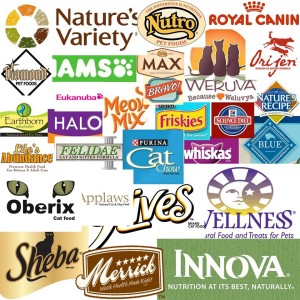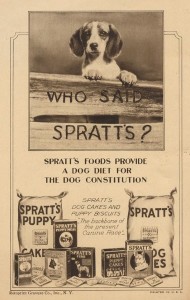Written by Beth Laubenthal, January 2014.
This article is the first in a series of four focused on the pet food industry manufacturing process. This one discusses the formation of the pet food industry and its evolution. The others are, in order, AAFCO: Their labeling requirements and the “Rules”, The Rendering Process: From the Raw Materials to Your Store Shelves, ending with Decoding Kibble: The Ingredients. None of this is intended to frighten anyone. The objective is to educate people, arming them with the information they need to make better food choices for their pets. If these articles are of any value to you, I hope you will share them and “pay it forward” for other pet owners!
 Dogs and cats accompanied human advancement into modern day living. Dogs began associating with humans some 15,000 years ago when humans were hunter/gatherers. Cats began associating with humans about 3,000 years later, just as we entered the agricultural revolution era.
Dogs and cats accompanied human advancement into modern day living. Dogs began associating with humans some 15,000 years ago when humans were hunter/gatherers. Cats began associating with humans about 3,000 years later, just as we entered the agricultural revolution era.
Cats and dogs survived on a diet of raw meat (from the rodents they caught and consumed along with animals the dog helped hunt) along with scraps left by humans. They did well on this diet for thousands of years. In terms of our relationships to cats and dogs, the pet food industry – the commercialization of pet food – is a very new idea. And one that is in constant state of evolution.
In 1860, an American named James Spratt on a business trip to England noticed that dogs were being fed leftover hardtack (a mixture of flour, salt, water and fat) thrown from ships. He thought he could capitalize on the practice, so he combined wheat meal, vegetables, beetroot and beef blood and became the first to patent a dog biscuit, putting forth the first tiny roots of what would become today’s behemoth pet food industry.
Spratt, despite popular belief, did not invent those dog biscuits. Hardtack biscuits were offered to dogs as treats going back as far as 1792. What Spratt did that made him famous was to be the first to test out a different formula and patent it.
 Manufacturing of Spratt’s patented biscuit moved to New York in 1890 and enjoyed ever increasing popularity. It wouldn’t be until 1907, a full seventeen years later, before another manufacturer entered the scene. The company, F.H. Bennett Biscuits Co., introduced bone shaped “Milk-Bone” biscuits and was credited as the first to market the “whole nutrition” concept. Those biscuits were made with meats, cereals, milk, liver oil, and vitamins, and packaged in boxes, not bulk, to meet the needs of different breed sizes.
Manufacturing of Spratt’s patented biscuit moved to New York in 1890 and enjoyed ever increasing popularity. It wouldn’t be until 1907, a full seventeen years later, before another manufacturer entered the scene. The company, F.H. Bennett Biscuits Co., introduced bone shaped “Milk-Bone” biscuits and was credited as the first to market the “whole nutrition” concept. Those biscuits were made with meats, cereals, milk, liver oil, and vitamins, and packaged in boxes, not bulk, to meet the needs of different breed sizes.
In the 1920s, after WW1, the popularity of the automobile led to a surplus of horses and cheap horse meat. In 1922, a horse dealer created the first canned dog food company, called Ken L Ration. P.M. Chappel, the head of the company, has been said to have gone up and down the street, asking pet stores to display and use his product.
Canned horse meat became so popular, thanks to a heavy marketing campaign, that it held 90 percent of the market… until World War II when the government started to ration meat and tin, and dry dog biscuits become favorable once again.
Around 1956, Purina introduces the first extruded kibble: Purina Dog Chow. This was highly successful because it appealed to both the dog and the human buying it. Purina used the same technology to create extruded cereal for humans. Kibble became easier to digest for pets and more appealing to the buyers.
In 1958, a The Pet Food Institute was founded. Shortly after that, it started an anti-raw, anti-table scrap campaign focused on getting pet owners to stop feeding their dogs anything but commercial dog food. They funded so-called reports that were published in magazines, extolling the many “benefits” of processed dog foods, and even created a radio spot about “the dangers of table scraps”, perhaps one of the first PSA’s (public safety announcements) ever, albeit a disingenuous one.
The industry boomed after the advent of cooked extruded kibble. 1960’s brought Cat Chow. Meow Mix came to the market in the 1970’s. The 70’s also saw Hills introducing symptom specific “prescription” foods only available through a veterinarian.
Between the invention of modern day kibble and the late 1970’s, pets were mysteriously dying of heart disease despite eating “complete and balanced food.” No one could figure out why. The problem was eventually traced to a taurine deficiency. Cats cannot synthesize taurine on their own. Certain breeds of dogs cannot make sufficient amounts of taurine to satisfy their daily needs. Taurine is crucial for heart health, reproductive health and vision for animals. Taurine is found naturally in raw meats, especially in dark meats such as beef, pork and heart, but is easily destroyed by heat. In the 1980’s, taurine added into the pet food and the problem was resolved.
Starting around 2007, pet owners started to take notice that something was not right with pet food. In 2007, over 8,500 pets died and tens of thousands were sickened from tainted pet foods. In the largest recall in American history, over 5,000 pet food products, most manufactured by Menu foods, was pulled from grocery stores, pet stores and specialty stores all across the country. In 2012, there were several recalls due to salmonella, moldy foods, and other problems. In 2013, there were over 30 different pet food products recalled because of salmonella contamination, unapproved antibiotic residue, and chemical contamination.
Feeding a raw diet is gaining more popularity due, in part, to the rising numbers of recalls on standard commercial pet foods. Raw food companies such as Bravo, Vital Essentials, Halo Pets, and Primal have started to flourish as more people begin seeking alternatives to dry kibble and canned foods for their pets. A broader understanding of today’s manufacturing practices and the type and quality of ingredients used, and the huge gulf between that information and the marketing claims for the foods is provoking distrust and disillusion in the general pet-owning population. The burgeoning awareness that our pets have never been sicker is fueling that uneasiness and pushing pet owners to do their own research into pet nutrition. A slow but massive shift towards feeding pets a fresher, more species-appropriate diet has begun to take place.
If you enjoyed this article or found it informative, please “Like” it, “Tweet” it, or share it using any of the buttons below. And don’t forget to check out our FB page, join the discussions in our awesome FB group and follow us on Twitter!
Created 02/17/14; Updated 08/11/14

